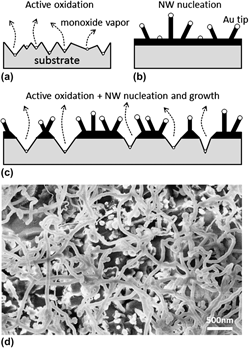Article contents
GeOx and SiOx nanowires grown via the active oxidation of Ge and Si substrates
Published online by Cambridge University Press: 12 July 2011
Abstract

In this study, we show that the volatile monoxide species generated during the active oxidation of Ge and Si substrates can be utilized in the presence of Au catalytic nanoparticles to nucleate and grow GeOx and SiOx nanowires. A simple thermodynamic model is developed to ascertain the critical O2 partial pressure as a function of temperature required for the active oxidation of Ge and Si substrates and is experimentally verified. The ideal conditions for uniform nanowire growth across the substrate are shown to be primarily dependent on the O2 partial pressure, the annealing temperature and thicknesses of the surface oxide, and deposited Au. The role of a metastable surface oxide separating the active oxidation and NW nucleation processes is also discussed.
Keywords
- Type
- Articles
- Information
- Journal of Materials Research , Volume 26 , Issue 17: Focus Issue: Nanowires: Fundamentals and Applications , 14 September 2011 , pp. 2240 - 2246
- Copyright
- Copyright © Materials Research Society 2011
References
REFERENCES
- 8
- Cited by


